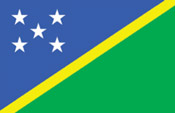NEW INTERNATIONALIST ISSUE 430
It is not hard to imagine these Pacific islands as they were in the 1500s when a Spanish explorer came, found gold, and gave the Solomon Islands their name. The islands are still dotted with homes made from wood and sago palm and some 80 per cent of the population still have a subsistence lifestyle through farming, fishing, or hunting and gathering. Ownership of land and property is still spread out over family and kin networks, rather than being kept by individuals. This is what remains of the ‘old’ Solomon Islands where life is ruled by kastom – commonly accepted behaviour rooted in tradition.
 But visitors who arrive in the capital city of Honiara, get one of the many taxis beating out reggaeton and weave their way through the car and footpath traffic, will see the ‘new’ Solomon Islands in full force. In Honiara are mingled many different Melanesian tribes from the islands, Polynesians and Micronesians wearing lavalavas (sarongs), as well as wakus (Chinese entrepreneurs) going about their business. Kastom here is more about the strength of local cultural norms in the face of foreign influences; life is more about the balance between where you are from and where you want to go.
But visitors who arrive in the capital city of Honiara, get one of the many taxis beating out reggaeton and weave their way through the car and footpath traffic, will see the ‘new’ Solomon Islands in full force. In Honiara are mingled many different Melanesian tribes from the islands, Polynesians and Micronesians wearing lavalavas (sarongs), as well as wakus (Chinese entrepreneurs) going about their business. Kastom here is more about the strength of local cultural norms in the face of foreign influences; life is more about the balance between where you are from and where you want to go.
Economic development and aid have been restarted following a period of violent conflict between people from the islands of Malaita and Guadalcanal (where Honiara is situated) in 2003. The economy grew by almost five per cent in the first year of peace and, to the surprise of many a Western economist, studies found this growth was entirely due to industrious small-scale fishers, farmers and other family-run businesses….Read the article

I am glad to be a visitant of this perfect weblog, appreciate it for this rare info!
April 10th, 2012 at 12:19 pm